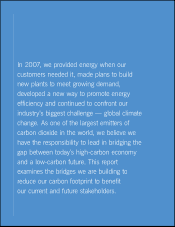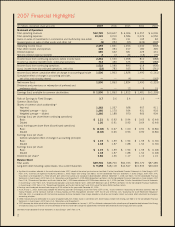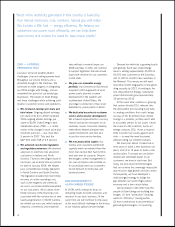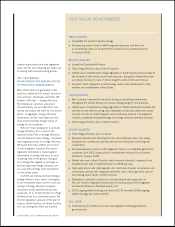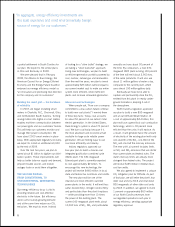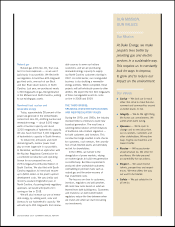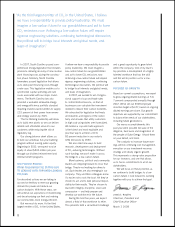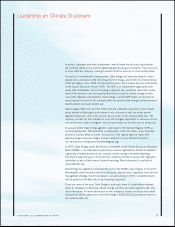Duke Energy 2007 Annual Report Download - page 7
Download and view the complete annual report
Please find page 7 of the 2007 Duke Energy annual report below. You can navigate through the pages in the report by either clicking on the pages listed below, or by using the keyword search tool below to find specific information within the annual report.
DUKE ENERGY 2007 SUMMARY ANNUAL REPORT 5
investor expectations and new regulatory
rules; and (4) from following the status quo
to leading with forward-looking policies.
THE FIRST BRIDGE:
FROM PRODUCTION (MAKING WATTS)
TO EFFICIENCY (SAVING WATTS)
Most of the electricity generated in this
country is fueled by four natural resources:
coal, uranium, natural gas and water. We
include a fifth fuel — energy efficiency.
By helping our customers use power
more efficiently, we can help them save
money and reduce the need for new power
plants. In aggregate, energy efficiency
investments are the least expensive and
most environmentally benign source of
energy for our customers.
Why isn’t more being done to promote
energy efficiency? As co-chair of the
National Action Plan on Energy Efficiency
and the Alliance to Save Energy, I reviewed
state regulatory plans for energy efficiency.
We found that many utilities don’t invest
in such programs, because the current
regulatory framework is biased against
investments in energy efficiency in favor
of putting steel in the ground. Our goal
is to change that regulatory paradigm so
that earnings from energy efficiency are
on a par with earnings from investments
in new power plants.
In 2007, we introduced Duke Energy’s
energy efficiency plan, which is designed
to set investment returns for the costs and
savings of energy efficiency programs.
Customers would benefit because they
would pay 10 to 15 percent less for energy
efficiency than for a new power plant. We
filed for regulatory approval of this plan in
Indiana, North Carolina and South Carolina.
As I was writing this letter, we reached
2007 MAJOR ACHIEVEMENTS
FIRST QUARTER
Completed the spinoff of Spectra Energy.
Received approval to build an 800-megawatt advanced coal-fired unit
at our Cliffside station in western North Carolina (final air permit received
in January 2008).
SECOND QUARTER
Issued first Sustainability Report.
Filed energy efficiency plan in North Carolina.
Helped pass comprehensive energy legislation in South Carolina that provides for
the recovery of new nuclear plant financing costs during the construction phase
and allows recovery of costs of certain reagents used in emission removal.
Acquired 1,000 megawatts of wind energy assets under development in the
western and southwestern United States.
THIRD QUARTER
Met customers’ demand for electricity during record-setting summer heat
throughout the service territory and record-setting drought in the Carolinas.
Helped pass comprehensive energy legislation in North Carolina that enables the
recovery of new plant financing costs during the construction phase and allows
recovery of costs of certain reagents used in emission removal. The legislation
includes a workable renewable energy and energy efficiency portfolio standard.
Filed energy efficiency plan in South Carolina.
FOURTH QUARTER
Filed energy efficiency plan in Indiana.
Received remand order affirming the Ohio rate stabilization plan. The ruling
maintains the current price and provides for the continuation of existing rate
components.
Received approval to build a 630-megawatt cleaner-coal integrated gasification
combined cycle (IGCC) power plant in southwestern Indiana (final air permit
received in January 2008).
Settled rate case in North Carolina, which reduced industrial, commercial and
residential rates with no material impact on 2008 earnings.
Filed applications with state regulators for certificates of public convenience and
necessity to add two 620-megawatt combined cycle, natural gas-fired units at
two existing power plants in North Carolina.
Submitted a combined construction and operating license application to
the U.S. Nuclear Regulatory Commission for the proposed 2,234-megawatt
Lee Nuclear Station in Cherokee County, S.C.
2007 ongoing diluted earnings per share of $1.24 exceeded 2006 ongoing
diluted earnings per share of $0.99.
FULL YEAR
Continued push for federal cap-and-trade legislation limiting greenhouse
gas emissions.
■
■
■
■
■
■
■
■
■
■
■
■
■
■
■
■
■


